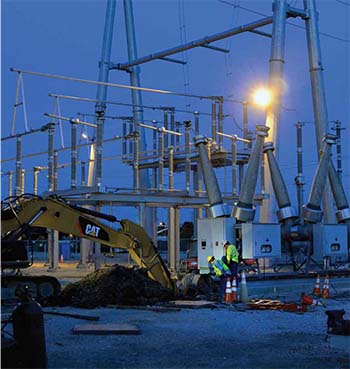Regional and economic planning update
 ATC is involved with several planning efforts that address regional, inter-regional and Eastern Interconnection-wide needs that could impact grid operations. Proposed legislation regarding renewable energy developments and greenhouse gas emission reductions continues to evolve at the federal level. ATC monitors these discussions and continues to undertake internal analyses and participate in regional studies to anticipate the future demands on the transmission system.
ATC is involved with several planning efforts that address regional, inter-regional and Eastern Interconnection-wide needs that could impact grid operations. Proposed legislation regarding renewable energy developments and greenhouse gas emission reductions continues to evolve at the federal level. ATC monitors these discussions and continues to undertake internal analyses and participate in regional studies to anticipate the future demands on the transmission system.
Eastern Interconnection Planning Collaborative
Building on a planning initiative started in 2010, a group of 25 registered planning authorities continues to refine plans for transmission grid needs from the Rocky Mountains to the east coast and several Canadian provinces. Recent “stress test” studies performed by the collaborative show that the system has the potential to increase transfers in 2018 by 1,100 megawatts to 5,000 megawatts. In 2023, transfers could be increased between 550 and 5,000 megawatts, depending on the regions involved. These transfers are in addition to the transfers that already take place in the base case and would involve no transmission being built other than what is already included in existing plans across the interconnection. Two additional scenarios using 2018 and 2023 models are being studied using updated plans from the previous study and a drought scenario in part of the Eastern Interconnection with transfers coming from non-drought areas.
Market constraints
Two of the three narrow constrained areas identified in the MISO region are associated with ATC. The two areas are within the Wisconsin and Upper Michigan System. Congestion within the northern WUMS study area declined significantly since 2012 due in part to transmission upgrades and generation additions. The Pleasant Prairie-Zion Energy Center MVP transmission line also has helped alleviate congestion. We continue to evaluate projects that may eliminate the NCA designation.
MISO Transmission
Expansion Planning MISO planning studies address long and short-term issues as well as targeted needs. Long-term studies primarily look at value-based options that provide economic benefits in the 10- to 20-year horizon. Short term planning is primarily driven by transmission owners’ reliability and NERC compliance needs in a five- to 10-year period.
MTEP 14
Our staff participates in the short term reliability and economic studies in a variety of ways: ensuring accurate project information is included in the MISO database, building and reviewing models, correlating needs identified by MISO analyses with specific ATC projects and participating in various studies and stakeholder forums.
Other MISO planning activities
Our Strategic Projects staff participates in various technical and policy discussions and provides future direction of MTEP activities. We also are involved in joint planning studies with neighboring regional transmission organizations, including PJM and SPP. MISO and PJM coordinated, conducted and analyzed several Market Efficiency Project studies. This analysis is reviewed by an inter-regional planning stakeholder advisory committee and typically examines economic projects that could benefit both RTOs and qualify for cross border cost-sharing.
FERC Order 1000
We also have participated in MISO’s efforts to implement a competitive bidding process for selecting developers of Market Efficiency Projects and MVPs as part of its compliance with FERC Order 1000. ATC has applied to become a qualified developer and also has participated in the stakeholder process for drafting the business practice rules for selecting developers.
In May 2014, FERC accepted revisions to our local process to comply with requirements that transmission needs driven by public policy requirements be considered in planning.
